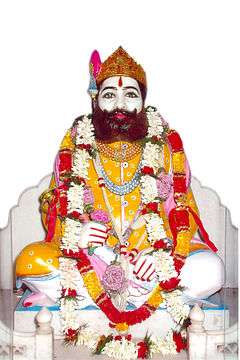Agrahari

Agrahari, Agraharee or Agarhari is an Indian and Nepali Madhesi Vaishya community, claimed to be descendants of legendary king Agrasena.[1] Predominately, they founded in Indian state of Uttar Pradesh,[2] and Madhya Pradesh and Terai region of Nepal.[3]
History
In Chhattisgarh, Central Provinces of British India,[4] some of few Agrahari were Malgujars/Zamindars.[5] The ruler of Raigarh awarded the title Shaw to Agraharis. The title still continues.[6]
Sikhism in Agrahari
Most of Agrahari follows Hinduism, although some are Sikh. The majority of Agrahari Sikhs found in eastern Indian state Bihar and West Bengal. Author Himadri Banerjee wrote in his book "The Other Sikhs: A View from Eastern India", that Agrahari was converted in Sikhism during Mughal period by Guru Tegh Bahadur Singh Ji, 9th Guru of Sikhs. Mughal ruler was enforcing to Hindus to convert to Islam, but Agrahari refused to convert into Islam and they accepted Khalsa, led by Guru Tegh Bahadur Singh for protecting their life and religion. Other legend says that Agrahari Sikh is a community of Ahom converts to Sikhism from the time of 9th Guru Tegh Bahadur’s travel to Assam. They also known as "Bihari Sikhs" have lived for centuries in Bihar. They are running several separate Gurudwara in Bihar and West Bengal. The majority of these Sikh are found in Sasaram, Gaya and Calcutta of Bihar and West Bengal. Agrahari Sikh not only came in Eastwards of India, they are also present in some party of Uttar Pradesh.
Gotra
Maharaja Agrasena established 18 Gotras (or clan) for each of his 18 sons based on the names of their Guru and divided his empire among them. Due to this epics, it is consider as agrahari belongs from Kuchchal/Kuchchhal/Kanchhal/Kuchhal clan (Gotra); which is originally established by Agrasena. Kashyapa is the Guru Gotra of Agrahari. The gotra Kashyap as by the name of rishi kashyapa is being considered and used on large by Agrahari.
Surname & title
Agrahari often use their community name as surname. However, many people using Gupta, Bania or Baniya or Vanik or Banik, Shaw and Vaishya or Vaishy or Vaish or Baishya or Baish.[7]
Reservation
The Mandal Commission[8] designated the Agrahari of Bihar[9] and Jharkhand as Other Backward Class[10] in the Indian caste system of positive discrimination.[11]
See also
References
- ↑ Kumar Suresh Singh; Amir Hasan; Hasan, Baqr; Raza Rizvi; J. C. Das (2005). People of India: Uttar Pradesh , Voume 42, Part (illustrated ed.). Anthropological Survey of India. p. 66. ISBN 978-81-73041-14-3.
- ↑ Lalit Mohan Sankhdher (1974). Caste Interaction in Village Tribe: An anthropological Case Study of the Tribes in Dhanaura Village in Mirzapur District of Uttar Pradesh. K. P. Publications. p. 10-1.
- ↑ Shibani Roy; S. H. M. Rizvi (2002). Encyclopaedia of Indian surnames. B.R. p. 6. ISBN 978-81-7646-247-1.
- ↑ Richard Gabriel Fox (1969). From Zamidar to ballot box: community change in a north Indian market town. Cornell University Press. p. 286.
- ↑ Richard Gabriel Fox (1969). From Zamidar to ballot box: community change in a north Indian market town. Cornell University Press. p. 83.
- ↑ Richard Gabriel Fox (1969). From Zamidar to ballot box: community change in a north Indian market town. Cornell University Press. p. 90.
- ↑ Kumar Suresh Singh (1996). Identity, Ecology, Social Organization, Linkages and Development Process: a Quantitative Profile. Anthropological Survey of India. p. 18.
- ↑ Sharma, Shish Ram (2002). Protective Discrimination: Other Backward Classes in India, Raj Publications. Raj Publications. p. 224. ISBN 978-81-86208-23-6.
- ↑ Ghosh, Subir Kumar (1996). Reservation in services: a manual for government and public sector. Akshar Publication. p. 189. ISBN 978-81-75290-00-6.
- ↑ Sharma, Shish Ram (2002). Protective Discrimination: Other Backward Classes in India, Raj Publications. Raj Publications. p. 47. ISBN 978-81-86208-23-6.
- ↑ Sharma, Shish Ram (2002). Protective Discrimination: Other Backward Classes in India, Raj Publications. Raj Publications. p. 50. ISBN 978-81-86208-23-6.